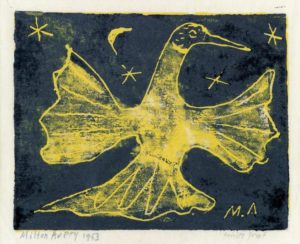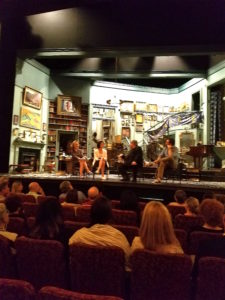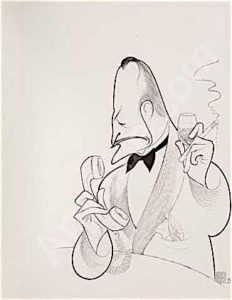 Lauritz Melchior sings the Prize Song from Wagner’s Die Meistersinger in Two Sisters from Boston, directed by Henry Koster and released in 1946. This scene, which also features June Allyson and Jimmy Durante, is a fictionalized but surprisingly accurate version of an acoustic recording session that predates the introduction in 1925 of the studio microphone:
Lauritz Melchior sings the Prize Song from Wagner’s Die Meistersinger in Two Sisters from Boston, directed by Henry Koster and released in 1946. This scene, which also features June Allyson and Jimmy Durante, is a fictionalized but surprisingly accurate version of an acoustic recording session that predates the introduction in 1925 of the studio microphone:
(This is the latest in a series of arts-related videos that appear in this space each Monday, Wednesday, and Friday)


 Mrs. T and I love the art of
Mrs. T and I love the art of  Alan Fern wrote well about Avery’s printmaking technique in his “technical note” to Milton Avery: Prints 1933-1955, the standard catalogue of Avery’s prints:
Alan Fern wrote well about Avery’s printmaking technique in his “technical note” to Milton Avery: Prints 1933-1955, the standard catalogue of Avery’s prints: This homely, one-of-a-kind quality is an important part of what makes Avery’s woodcuts so appealing. In addition, the necessary simplifications of printmaking were very much in tune with his growing inclination to pare his work down to the bare essentials (as was also the case with Fairfield Porter, another of my favorite painters and a printmaker of like distinction).
This homely, one-of-a-kind quality is an important part of what makes Avery’s woodcuts so appealing. In addition, the necessary simplifications of printmaking were very much in tune with his growing inclination to pare his work down to the bare essentials (as was also the case with Fairfield Porter, another of my favorite painters and a printmaker of like distinction).
 Like many other major newspapers, The Wall Street Journal has started presenting special events for its subscribers. The editors approached me a few weeks ago about taking part in a theatrical event, a post-show talkback that I would moderate. When asked what show I thought might be most attractive to our readers, I suggested, among others, the Broadway revival of Noël Coward’s Present Laughter, which I had recently
Like many other major newspapers, The Wall Street Journal has started presenting special events for its subscribers. The editors approached me a few weeks ago about taking part in a theatrical event, a post-show talkback that I would moderate. When asked what show I thought might be most attractive to our readers, I suggested, among others, the Broadway revival of Noël Coward’s Present Laughter, which I had recently  Mrs. T and I dined before the show at
Mrs. T and I dined before the show at  When the play was over, my Wall Street Journal handler took me backstage to the greenroom, where Moritz von Steulpnagel awaited me. We exchanged a few brief words as the house was clearing out, then went on stage to talk to the subscribers while the women panelists changed into civilian clothes.
When the play was over, my Wall Street Journal handler took me backstage to the greenroom, where Moritz von Steulpnagel awaited me. We exchanged a few brief words as the house was clearing out, then went on stage to talk to the subscribers while the women panelists changed into civilian clothes. I thought it might be fun to tell the audience about how Mrs. T had seen Kevin Kline on the same stage in On the Twentieth Century. “Omigod, I saw Kevin in that show, too!” Kate said, laughing happily. This inspired me to ask about her previous appearance in Present Laughter, a 1982 Circle in the Square revival in which she’d
I thought it might be fun to tell the audience about how Mrs. T had seen Kevin Kline on the same stage in On the Twentieth Century. “Omigod, I saw Kevin in that show, too!” Kate said, laughing happily. This inspired me to ask about her previous appearance in Present Laughter, a 1982 Circle in the Square revival in which she’d  On the other hand, such memories are made to be shared, and it was unutterably lovely to spend a few minutes talking to a great lady of the theater about her own memories of working with a legend. And when Mrs. T and I take her father to see the BroadwayHD telecast of Present Laughter later this year, it will be no less lovely to sit in a darkened movie house in Connecticut, point at the screen, and say, I remember! We were sitting in the third row, laughing in the dark—and wasn’t Kate Burton nice?
On the other hand, such memories are made to be shared, and it was unutterably lovely to spend a few minutes talking to a great lady of the theater about her own memories of working with a legend. And when Mrs. T and I take her father to see the BroadwayHD telecast of Present Laughter later this year, it will be no less lovely to sit in a darkened movie house in Connecticut, point at the screen, and say, I remember! We were sitting in the third row, laughing in the dark—and wasn’t Kate Burton nice?